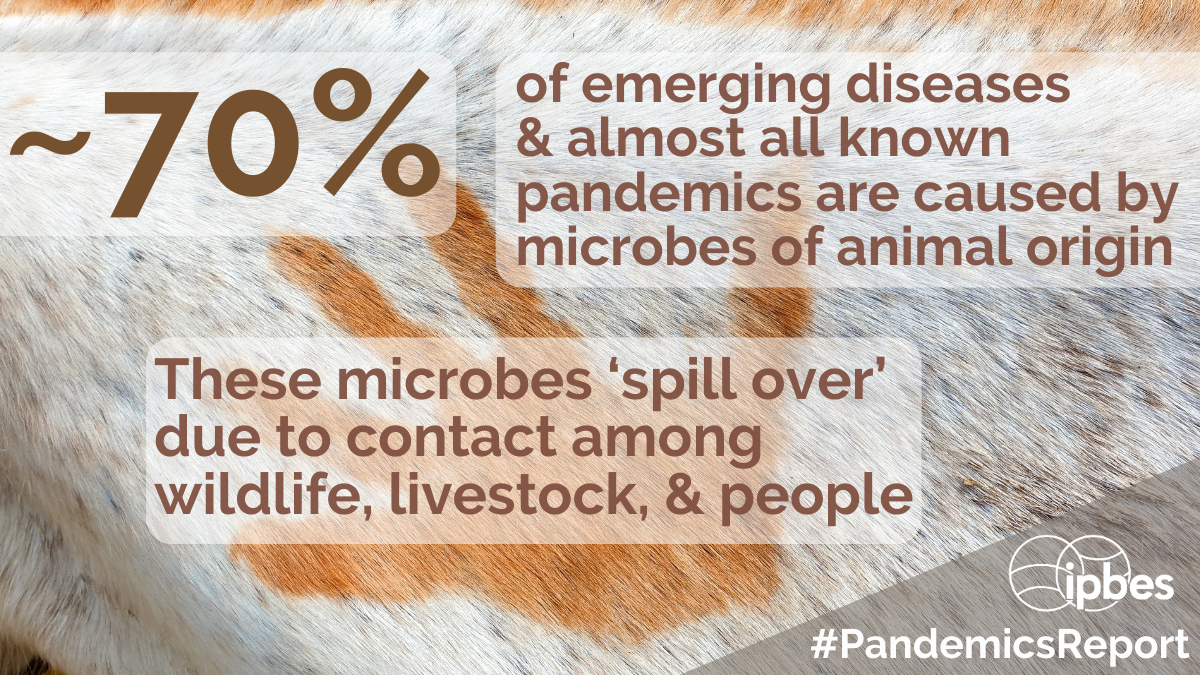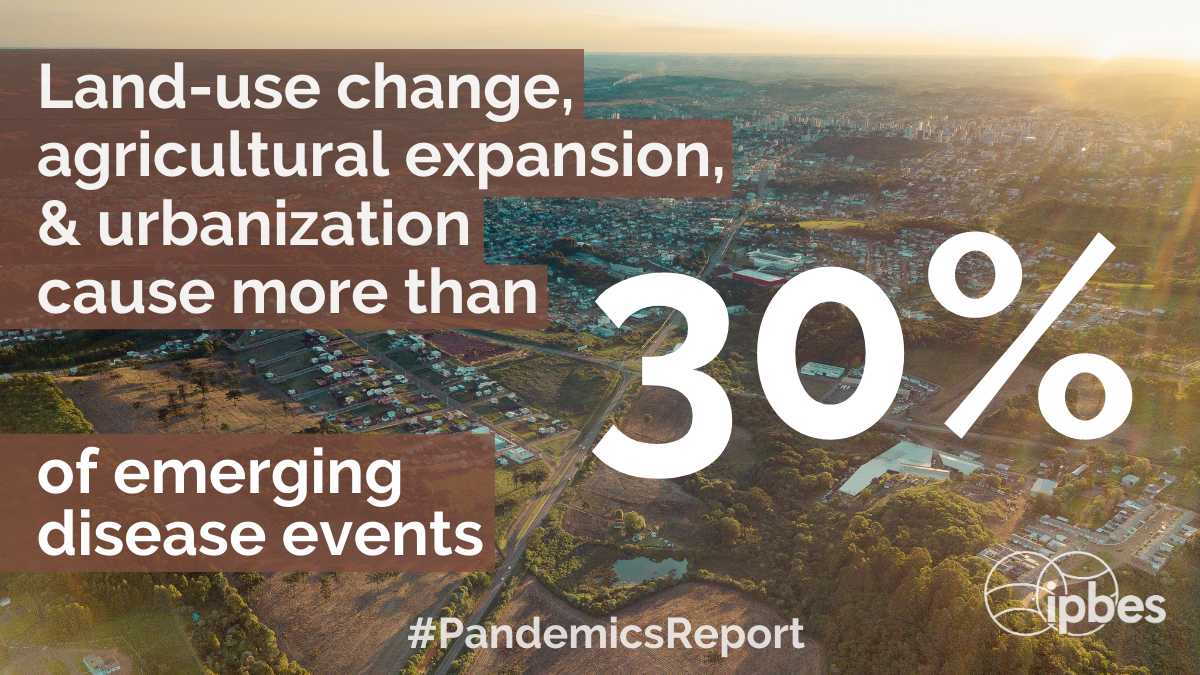IPBES Report on Escaping the Era of Pandemics
First published in Sanctuary Asia,
Vol. 40
No. 10,
October 2020
Experts Warn Worse Crises to Come, Options Offered to Reduce Risk
• 5,40,000 - 8,50,000 unknown viruses in nature could still infect people
• Current economic impacts are 100 times the estimated cost of prevention
Future pandemics will emerge more often, spread more rapidly, do more damage to the world economy and kill more people than COVID-19 unless there is a transformative change in the global approach to dealing with infectious diseases, warns a major new report on biodiversity and pandemics by 22 leading experts from around the world.
Convened by the Intergovernmental Science-Policy Platform on Biodiversity and Ecosystem Services (IPBES) for an urgent virtual workshop about the links between degradation of nature and increasing pandemic risks, the experts agree that escaping the era of pandemics is possible, but that this will require a seismic shift in approach, from reaction to prevention.

Courtesy: IPBES.
COVID-19 is at least the sixth global health pandemic since the Great Influenza Pandemic of 1918, and although it has its origins in microbes carried by animals, like all pandemics its emergence has been entirely driven by human activities, says the report released on Thursday, October 29, 2020. It is estimated that another 1.7 million currently 'undiscovered' viruses exist in mammals and birds - of which up to 8,50,000 could have the ability to infect people.
“There is no great mystery about the cause of the COVID-19 pandemic - or of any modern pandemic”, said Dr. Peter Daszak, President of EcoHealth Alliance and chair of the IPBES workshop. “The same human activities that drive climate change and biodiversity loss also drive pandemic risk through their impacts on our environment. Changes in the way we use land; the expansion and intensification of
agriculture; and unsustainable trade, production and consumption disrupt nature and increase contact between wildlife, livestock, pathogens and people. This is the path to pandemics."
Pandemic risk can be significantly lowered by reducing the human activities that drive the loss of biodiversity, by greater conservation of protected areas, and through measures that reduce unsustainable exploitation of high biodiversity regions. This will reduce wildlife-livestock-human contact and help prevent the spillover of new diseases, says the report.

Courtesy: IPBES.
"The overwhelming scientific evidence points to a very positive conclusion," said Dr. Daszak. “We have the increasing ability to prevent pandemics - but the way we are tackling them right now largely ignores that ability. Our approach has effectively stagnated - we still rely on attempts to contain and control diseases after they emerge, through vaccines and therapeutics. We can escape the era of pandemics, but this requires a much greater focus on prevention in addition to reaction."
“The fact that human activity has been able to so fundamentally change our natural environment need not always be a negative outcome. It also provides convincing proof of our power to drive the change needed to reduce the risk of future pandemics - while simultaneously benefiting conservation and reducing climate change. "
The report says that relying on responses to diseases after their emergence, such as public health measures and technological solutions, in particular the rapid design and distribution of new vaccines and therapeutics, is a “slow and uncertain path”, underscoring both the widespread human suffering and the tens of billions of dollars in annual economic damage to the global economy of reacting to pandemics.
_1604058011.png)
Courtesy: IPBES.
The IPBES workshop report is one of the most scientifically robust examinations of the evidence and knowledge about links between pandemic risk and nature since the COVID-19 pandemic began – with contributions from leading experts in fields as diverse as epidemiology, zoology, public health, disease ecology, comparative pathology, veterinary medicine, pharmacology, wildlife health, mathematical modelling, economics, law and public policy.
The report is strongly scientifically substantiated, with almost than 700 cited sources – more than 200 of which are from 2020 and 2019 – which offers decision-makers a valuable analytical snap-shot of the most up-to-date data currently available. The report also offers a number of policy options that would help to reduce and address pandemic risk. Among these are:
- Launching a high-level intergovernmental council on pandemic prevention to provide decision-makers with the best science and evidence on emerging diseases; predict high-risk areas; evaluate the economic impact of potential pandemics and to highlight research gaps. Such a council could also coordinate the design of a global monitoring framework.
- Countries setting mutually-agreed goals or targets within the framework of an international accord or agreement – with clear benefits for people, animals and the environment.
- Institutionalising the ‘One Health’ approach in national governments to build pandemic preparedness, enhance pandemic prevention programs, and to investigate and control outbreaks across sectors.
- Developing and incorporating pandemic and emerging disease risk health impact assessments in major development and land-use projects, while reforming financial aid for land-use so that benefits and risks to biodiversity and health are recognised and explicitly targeted.
- Ensuring that the economic cost of pandemics is factored into consumption, production, and government policies and budgets.
- Enabling changes to reduce the types of consumption, globalised agricultural expansion and trade that have led to pandemics – this could include taxes or levies on meat consumption, livestock production and other forms of high pandemic-risk activities.
- Reducing zoonotic disease risks in the international wildlife trade through a new intergovernmental ‘health and trade’ partnership; reducing or removing high disease-risk species in the wildlife trade; enhancing law enforcement in all aspects of the illegal wildlife trade and improving community education in disease hotspots about the health risks of wildlife trade.
- Valuing Indigenous Peoples and local communities’ engagement and knowledge in pandemic prevention programs, achieving greater food security, and reducing consumption of wildlife.
- Closing critical knowledge gaps such as those about key risk behaviors, the relative importance of illegal, unregulated, and the legal and regulated wildlife trade in disease risk, and improving understanding of the relationship between ecosystem degradation and restoration, landscape structure and the risk of disease emergence.
Access the Report executive summary: http://bit.ly/PandemicReportExecSum
Access the full Report here: www.ipbes.net/pandemics
Key Statistics and Facts from the Report
• $8 trillion to $16 trillion: estimated cost of the COVID-19 pandemic, including $5.8 trillion to $8.8 trillion of 3 to 6 months of social distancing and travel restrictions (6.4 per cent to 9.7 per cent of global GDP)
• >1 trillion dollars: likely annual global economic damages due to pandemics
• $53 billion: Economic impact of the 2014 Ebola epidemic in West Africa
• $7 billion to $18 billion: Estimated cost of the Zika virus in South America and the Caribbean (2015 to 2017)
• $78 billion to $91 billion: total annual financial allocation for global biodiversity conservation
• >70 per cent: of emerging diseases (e.g. Ebola, Zika, Nipah encephalitis) caused by microbes found in animals (i.e. are classed as zoonotic pathogens) which ‘spill over’ due to contact among wildlife, livestock, and people
• Almost 100 per cent: of pandemics (e.g. influenza, SARS, COVID-19) have been caused by zoonoses
• Up to 1.7 million: current estimate of ‘undiscovered’ viruses in mammal and water birds, the hosts most commonly identified as origins of novel zoonoses
• Less than 2,000: currently catalogued viral diversity from these hosts (less than 0.1 per cent of the potential zoonotic viral risk has been discovered)
• 540,000 to 850,000: estimated number of viruses that could have the ability to infect humans
• 24 per cent: wild terrestrial vertebrate species traded globally
• US$107 billion: value of international legal wildlife trade in 2019, a 500 per cent increase in the last 15 years (since 2005), 2,000 per cent since the 1980s
• $7 billion to $23 billion: annual value of the world’s illegal wildlife trade [data incomplete]
• >400: microbes (viruses, bacteria, protozoa, fungi and other microorganisms) have emerged in people during the last five decades, more than 70 per cent of them originating in animals, mostly wildlife
• At least 6: Pandemics since the Great Influenza pandemic of 1918 -- three caused by influenza viruses, HIV/AIDS, SARS, and COVID-19, and the frequency is increasing
• 3 per cent (~35 million ha): Increase in agricultural area worldwide, 1992 to 2015, mostly converted from tropical forests
• 1 billion ha: anticipated area of land cleared globally by 2050
• >30 per cent: emerging infectious diseases attributed to land use change, agricultural expansion and urbanisation
• 75 per cent: approved antimicrobial drugs derived from natural or naturally derived compounds
• 12 million: estimated number of fungal species, one of which was the source of penicillin used to control bacterial infections and revolutionise medicine
• $55 billion: Global economic impact of H1N1 on tourism




_1604058011.png)